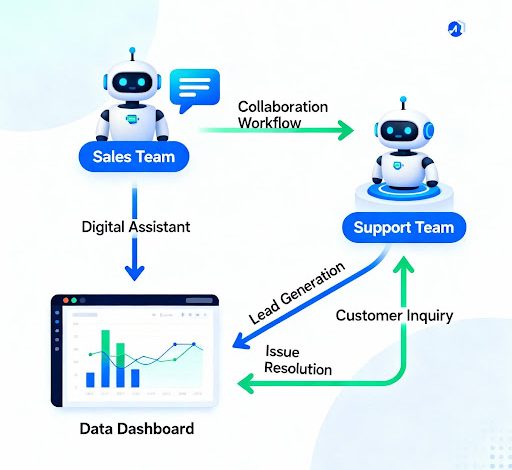
For 25 years, CRM systems have operated under the same basic premise: store customer data, track interactions, and hope sales reps keep everything updated. The problem is that this model never worked particularly well. Sales representatives spend only a small percent of their time actually selling. The rest gets consumed by administrative tasks, CRM updates, call logging, and chasing internal approvals.
Customer service teams fare no better. Most service representatives feel overwhelmed by their tools and report being flooded with unnecessary information that slows them down rather than helping them work faster.
We have treated CRM pain as an acceptable cost of doing business. It is not. The tools that were supposed to make teams more productive have instead created a bottleneck crisis that costs companies real money and real opportunities. But something fundamental is changing. AI is not just making CRM systems smarter. It is transforming them from passive databases into active execution engines that orchestrate work rather than simply document it.
The Workflow Bottleneck Crisis
The numbers tell a stark story. Sales reps spend up to 40% of their time on administrative work. That translates to nearly two full working days each week lost to non-revenue activities.
This administrative burden creates a cascade of problems. Deal cycles stretch longer. Revenue opportunities get missed. Sales representatives burn out. Turnover climbs. And perhaps worst of all, the data that CRM systems desperately need to function properly never gets entered accurately or completely. Sales leaders cannot forecast reliably. They miss critical objections that need handling. They fail to see obvious churn signals until it is too late.
The traditional CRM model creates a destructive cycle. Systems demand more data input to deliver better insights. But the more data entry required, the less time reps have to sell. The less they sell, the more pressure they face to update systems and justify their pipeline. It is a model that satisfies no one.
Customer service teams face parallel challenges. Support representatives toggle between five to fifteen different tools in their daily work. Each system requires separate logins, different interfaces, and unique workflows. Ticket routing happens manually. Knowledge base searches take too long. Escalations get delayed. Response times suffer. During this chaos, customers wait, frustration builds, and satisfaction scores drop.
Three Fundamental AI-Driven Workflow Transformations
AI is breaking this cycle by fundamentally restructuring how work gets done. Instead of requiring humans to feed systems, AI-powered workflows extract information automatically, make intelligent decisions, and trigger actions without constant human oversight.
Three core transformations are reshaping sales and service operations:
1. Automated Intelligence Replacing Manual Data Work
The first transformation eliminates the data entry bottleneck entirely. AI systems now automatically capture customer interactions from calls, emails, meetings, and chat conversations. They extract key information, update CRM records, log activities, and flag follow-up tasks without any manual input from sales reps.
This is not a simple transcription. Modern AI analyzes conversation content, identifies customer needs, detects sentiment shifts, recognizes buying signals, and maps stakeholder relationships. It understands context well enough to distinguish between a casual mention and a genuine objection. It knows when a customer is asking for information versus expressing dissatisfaction. According to recent data, AI-powered CRM systems can increase sales productivity by up to 25% simply by removing the manual data entry burden.
Lead scoring and qualification have moved from manual processes to automated intelligence. Instead of sales reps reviewing every inquiry and deciding which ones merit attention, AI evaluates leads continuously using signals from first-party data, third-party sources, and historical performance patterns. The system scores leads, determines the right engagement sequence, and routes opportunities to appropriate team members based on territory rules, expertise, and current workload.
McKinsey research shows that sales teams leveraging AI-powered tools can automate up to 80% of routine tasks, including data entry and record keeping. Companies implementing these systems report that high-performing sales teams use automation specifically to eliminate low-value tasks like manual data entry, administrative follow-ups, and internal status updates.
2. Real-Time Personalization at Scale
The second transformation enables personalization that would be impossible for humans to deliver manually. AI analyzes customer behavior patterns, purchase history, interaction preferences, and engagement signals to personalize every touchpoint in real time.
When a customer visits a website, AI identifies them, references their history, and adjusts content dynamically. When they open an email, the system tracks engagement and triggers appropriate follow-up sequences. When they interact with a chatbot, the conversation draws on complete context rather than starting from scratch each time. This level of coordination across channels used to require armies of people manually tracking customer journeys. Now it happens automatically.
Predictive analytics takes this further by anticipating customer needs before they surface. The AI does not wait for customers to complain about a problem. It identifies usage patterns that typically precede churn and triggers proactive outreach. It spots cross-sell opportunities based on similar customer profiles and surfaces relevant recommendations at optimal moments.
For customer service teams, this means AI can present support agents with complete context before they even pick up a call. The system knows what the customer purchased, when they last contacted support, what issues they reported previously, and what resolution worked.
3. Predictive Orchestration Driving Next-Best Actions
The third transformation moves beyond reactive responses to proactive orchestration. AI does not just wait for someone to decide what happens next. It determines the optimal action, schedules it, and in many cases executes it autonomously.
In the near future, AI agents will autonomously execute actions based on operational metrics and transaction histories. This is already happening in forward-looking organizations. When a deal stalls, the system detects the inactivity, analyzes why similar deals stalled previously, and automatically triggers re-engagement sequences. When a customer exhibits usage patterns that typically precede expansion, the AI flags the account, surfaces relevant upsell opportunities, and schedules outreach at the statistically optimal time.
This orchestration extends across entire sales and service ecosystems. AI coordinates between lead generation, qualification, conversion, and customer success functions. It decides whom to pursue, when to engage, through which channel, and with what message. It proposes solutions in real time, develops value propositions tailored to specific buyers, estimates ROI, and maps buying groups automatically.
But here’s where most implementations fall short: organizations assume they can simply layer AI on top of existing workflows and expect instant wins. Reality shows that without redesigning processes to leverage AI’s strengths—autonomous decision-making, continuous learning, and real-time orchestration—projects stall, budgets bloat, and ROI remains elusive.
Real-World Workflow Transformations Across Sectors
These are not theoretical capabilities. Organizations across industries are already seeing measurable results from AI-driven workflow redesigns.
In the insurance sector, companies have deployed AI chatbots that handle customer inquiries 24/7, resolving over 90% of pre-sales queries without human intervention.
Financial services firms are automating mortgage inquiry workflows that previously required days of back-and-forth communication. What used to take four days of provisioning time now happens in minutes. The AI unifies customer data across systems, enabling sales teams to understand and address customer needs immediately. This reduces errors, accelerates deal closure, and improves customer satisfaction.
Electronics retailers have implemented AI systems that analyze case histories to personalize problem resolution. When a customer contacts support, the AI reviews their purchase history, identifies similar cases, and recommends solutions that worked in comparable situations.
Implementation Realities: What Works and What Does Not
These results do not happen automatically. Successful AI workflow implementations require clear-eyed understanding of what works, what fails, and why.
According to Salesforce, the biggest mistake organizations make is treating AI as a bolt-on addition to existing processes. AI works best when workflows get redesigned around what the technology actually does well. That means moving away from human-centric processes where AI assists to AI-centric processes where humans provide oversight and judgment on high-value decisions.
Data quality determines everything. AI systems trained on incomplete, inconsistent, or outdated information produce unreliable outputs. Organizations must establish clear data governance policies, conduct regular data cleansing, implement validation rules, and create accountability for data accuracy. This is not glamorous work, but it is foundational. The best AI in the world cannot overcome garbage data.
Integration complexity kills many initiatives. Sales and service teams already use five to fifteen tools in their daily work. Adding AI capabilities that do not integrate seamlessly with existing systems just creates another silo. Successful implementations prioritize unified platforms that consolidate workflows rather than adding point solutions that increase complexity.
User adoption makes or breaks implementations. CRM systems have suffered from poor adoption for 25 years because they increase workload without delivering obvious value to the people doing data entry. AI changes this equation, but only if implementations actually reduce rep burden rather than simply adding new features that also get ignored. The systems that succeed are those that work invisibly in the background, extracting value without demanding additional effort.
Change management cannot be an afterthought. Teams resist new systems, especially when previous technology promises failed to deliver. Successful rollouts communicate benefits clearly, involve employees early in the process, provide role-specific training, offer ongoing support, and create incentives that encourage adoption. Organizations that skip this work end up with sophisticated technology that no one uses.
Security and compliance guardrails are non-negotiable. AI agents operating autonomously must function within predefined limits. This includes compliance requirements in regulated industries, rules determining when agents can send communications, and trust layers ensuring secure data handling. Systems that lack these safeguards create legal and reputational risks that far outweigh their benefits.
The Future Belongs to Intelligent Systems, Not Just Smart Tools
The trajectory is clear. We are moving from CRM as a digital filing cabinet to AI as a real-time operating system. The question is not whether this transformation happens, but how quickly organizations adapt to capture its benefits.
The competitive implications are significant. Organizations that continue treating CRM as a data storage problem will fall further behind those redesigning workflows around intelligent execution. Sales teams that still spend 70% of their time on administration cannot compete with teams where AI handles routine work and reps focus exclusively on relationship building and deal negotiation.
The most successful implementations will balance autonomous AI action with purposeful human oversight. For large strategic accounts where relationships matter most, AI will assist with account planning, territory design, and stakeholder management while humans drive engagement. For smaller accounts and transactional sales, AI will act more autonomously, managing outreach at scale and serving customers that reps could not profitably handle before.
This combination unlocks simultaneous growth and efficiency. Organizations can penetrate deeper into strategic accounts while expanding coverage across the long tail of smaller opportunities. They can deliver personalized experiences at scale without proportionally increasing headcount. They can respond to customer needs 24/7 without burning out their teams.
For organizations still treating CRM as a data repository, the writing is on the wall. The future belongs to companies that recognize workflows are not something you document in software. They are something software executes on your behalf.
Close the Execution Gap
The gap between AI hype and AI implementation is execution. Most organizations already know intelligent systems can eliminate administrative burden and accelerate sales cycles. The hard part is redesigning workflows that actually work, integrating tools that teams will use, and building trust in automated decisions. That’s where Faye operates. They don’t sell software or promise overnight transformation. They help you move from passive CRM to intelligent execution through strategic workflow redesign, whether that means comprehensive AI services that build literacy and alignment across your organization, or practical tools like Faye Agent Builder (FAB) for Sugar that put AI agents directly into your team’s hands without the complexity. The companies winning right now aren’t the ones with the fanciest technology. They’re the ones who figured out how to make it work.




